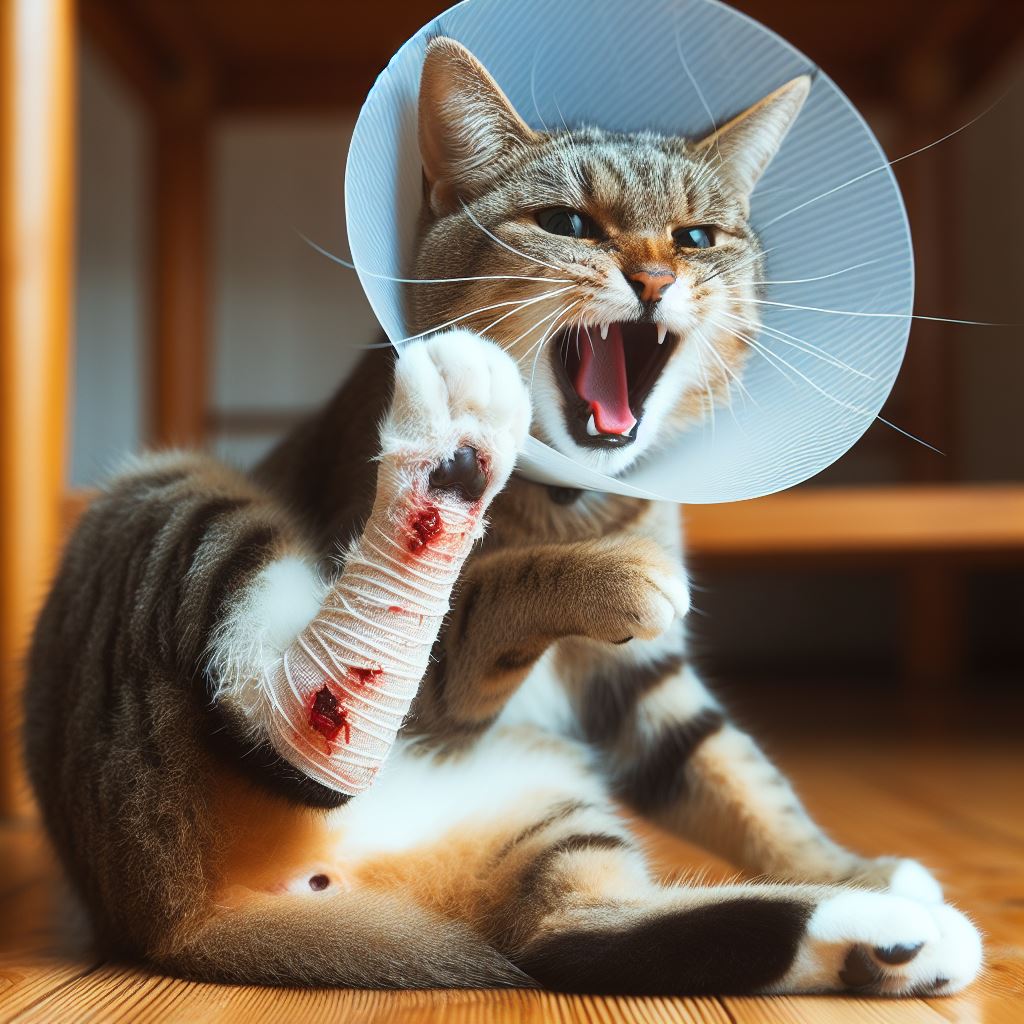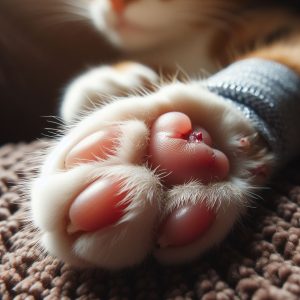Picking scabs off your cat can seem tempting. You see those dry, crusty layers of blood and want to peel them away to reveal the healed skin underneath. But resist the urge! Picking scabs off cats is not recommended and can do more harm than good.
As a loving cat owner, it’s understandable to want to groom your cat and care for its wounds. However, feline scabs serve an important protective purpose during healing. Premature removal can interrupt the healing process, lead to infection, and cause pain and stress for your cat.
In this comprehensive guide, we’ll explore why you shouldn’t pick scabs off cats when veterinary assistance is needed, proper scab care, and tips to prevent excessive scratching and scabbing in the first place. Follow these best practices to support your cat’s health and well-being.
Why You Should Avoid Picking Scabs Off Cats
Scabs form as part of the normal healing process when a cat’s skin is damaged from an injury, bite, scratch, or wound. Here’s what scabs do:
- Protect: Scabs create a protective barrier over injured skin and blood vessels underneath. This prevents bacteria from entering and causing infection.
- Absorb: Scabs soak up fluid and blood seeping from the wound. This helps clean and dry out the area so new skin can form.
- Support healing: As the damaged skin regenerates underneath, the scab provides stability and reinforcement until the new tissue is strong enough.
Prematurely tearing off scabs interferes with all of these healing functions. It leaves the wound exposed, slows the regrowth of skin, raises infection risk, and can damage healthy tissue.
Picking scabs also hurts! Scabs adhere tightly to wounds through fibrin threads. Forcibly detaching a scab rips these connections and stimulates pain in nerves. This provokes stress and anxiety in cats already suffering from an injury.
Unless medically necessary, let scabs fall off naturally once their job is complete. The healed skin beneath will be revealed intact, with minimal scarring. Never pick scabs off a cat yourself without veterinary guidance.
When Veterinary Assistance is Needed
While picking scabs yourself is inadvisable, there are some instances where a veterinarian may need to surgically debride a wound. Signs your cat’s scabs require medical attention include:
- Oozing/bleeding: Scabs should stay dry. Exudate or blood seeping out indicates an issue like infection.
- Foul odor: A putrid smell can signal a bacterial or fungal infection requiring antibiotic treatment.
- Spreading redness: Expanding redness around a scab can mean a worsening skin infection.
- Pus: Yellow/green discharge is a sign of infected fluid accumulation called an abscess.
- Pain/swelling: If the area under or around a scab is increasingly painful, swollen, or warm, vet examination is needed.
- Embedded foreign material: Scabs with debris like dirt, glass or plant material trapped require removal and cleaning to prevent problematic reactions.
- Interference with movement: Scabs that are large, thick, or located over joints can restrict mobility and cause discomfort.
If any of these red flags are present, schedule an appointment with your veterinarian right away. They can properly numb the area, detach embedded scabs, flush contaminants, treat infections, and prescribe medications as needed in a sterile surgical setting. Never try to cut open, drain, or dig out scabs yourself.
Proper Scab Care Guidelines

While scabs are doing their crucial wound coverage duties, proper care is still needed to keep them clean, protected, and watched for problems. Here are some guidelines:
- Keep the area dry: Moisture under scabs can encourage bacterial overgrowth. Keep your home humidity moderate and quickly dry your cat after baths. After swimming, gently pat dry instead of rubbing.
- Apply veterinarian-recommended ointments: Your vet may prescribe or recommend an antibiotic, antifungal, hydrocortisone, or silver sulfadiazine creams. Very sparingly apply just to the skin around the scab’s edges.
- Use Elizabethan collars: These cone-shaped collars deter licking, scratching, and biting that could dislodge scabs before healing finishes. Monitor your cat’s behavior and use collars as needed.
- Check for scratching/biting: Excessive self-trauma can remove scabs prematurely or spread infection. Redirect this behavior, trim nails, or use bitter anti-lick sprays.
- Gently cleanse wounds: Use cotton balls and water, saline solution, or other vet-recommended cleansers to gently dab and remove debris around scabs. Avoid harsh scrubbing.
- Watch for signs of infection/problems: Monitor scabs daily and check for odor, redness, swelling, discharge or other issues needing a vet visit.
- Let scabs detach naturally: It takes an average of 1-2 weeks for scabs to finish their work and separate on their own as new skin regenerates underneath. Be patient and let the process complete.
- See your vet if wounds won’t heal: If scabs remain stuck for longer than 2-3 weeks with no improvement, seek veterinary examination to find out why healing is delayed. Underlying problems may need treatment.
With diligent observation and care, your cat’s scabs can safely do their job without interference. Vet assistance is only needed if they show signs of complications.
Why Do Cats Get Scabs in the First Place?
To prevent scabs from forming, it helps to understand what causes skin injuries in cats:
- Scratching – Cats scratch not just to sharpen claws but also to groom, stretch, relieve anxiety, mark territory and more. But vigorous scratching on rough surfaces can damage skin.
- Fighting/rough play – Cats are territorial and will fight with other cats, dogs, and wildlife over turf, mates, and resources. Bites and scratches lead to wounds.
- Outside hazards – Outdoor cats face many dangers from cars, predators, parasites, toxic plants, debris, weather, and more. Injuries easily result.
- Allergies/skin disease – Allergic reactions, mites, ringworm and other skin disorders cause itching, leading cats to self-traumatize through excessive scratching, licking, chewing and biting themselves.
- Abscesses – Bite wounds can encapsulate bacteria deep under the skin, forming painful pockets of infection called abscesses which eventually rupture through the surface.
- Tumors/growths – Although rarer, cancers and benign masses on the skin can ulcerate, rupture and form chronic wounds.
To keep your cat’s skin healthy and intact, address the root causes of these injuries through the following preventive measures.
Tips to Prevent Excessive Scratching and Scabs
Here are some proactive ways to discourage scratching behaviors that lead to damaged skin and scabs in cats:
Provide Appropriate Scratching Posts
- Cats need outlets to satisfy their natural urge to scratch and groom claws.
- Provide scratching posts in areas your cat frequents. Offer different materials like sisal rope, cardboard, wood, and carpet so they have options to suit their preferences.
- Vertical scratching posts should be tall and sturdy enough for your cat to fully stretch upwards while scratching.
- Replace old, wobbly posts with fresh ones they will be more eager to use.
Use Cat Deterrent Sprays
- Apply anti-scratch sprays like Soft Paws on objects and areas you want your cat to avoid scratching – furniture, carpets, drapes, etc.
- These contain harmless but unpleasant tastes and scents to make items unappealing. Reapply regularly.
- For self-scratching, use anti-lick sprays with bitter citrus flavors on your cat’s skin to discourage biting and licking. Consult your vet first and don’t apply to open wounds.
Provide enrichment
- Bored, lonely, anxious and under-stimulated cats often obsessively scratch themselves.
- Provide enrichment through vertical space, playtimes, puzzle feeders, toys that reward pawing, cat trees/perches and opportunities for outdoor access like cat patios.
- Rotating toys keeps things interesting. Interactive play reduces stress and expending energy on appropriate things instead of themselves.
Address anxiety/stress
- Stress, fear, and conflict with other pets can manifest as over-grooming. Try calming plugins, establishing routines, and keeping litter boxes extremely clean.
- In extreme cases medication, but first consult a vet to identify and manage sources of emotional turmoil.
Use Soft Paws nail caps
- These vinyl caps glue over your cat’s existing nails to blunt scratching damage. Apply properly and change every 4-6 weeks when they fall off as nails regrow.
Check for skin irritations
- Itchy skin from allergies, parasites and infections drives cats to obsessively scratch, lick, and bite themselves, causing wounds.
- Note if your cat is focused on one area and schedule a vet dermatology visit to diagnose and treat any underlying conditions.
Keep their environment clean
- Germs on dirty bedding, litterboxes, food/water bowls and carpeting can worsen skin infections leading to more scratching.
- Wash bedding weekly in hot water, disinfect litter boxes between changes, and vacuum regularly.
Trim nails regularly
- With sharp claws, cats can more easily break skin when self-scratching. Clip tips monthly.
- Introduce trimming slowly with positive reinforcement so they accept it without stress. Have styptic powder on hand.
Use Elizabethan collars
- These cone collars deter biting, licking and scratching at existing wounds while scabs heal. Monitor to see if needed.
Flea preventatives
- Flea bites cause severe itching and inflammation. Use monthly spot-on treatments year-round even if your cat stays indoors. Treat home also.
Groom regularly
- Gentle brushing removes loose hair and dander while spreading calming pheromones. Weekly grooming minimizes knots and tangles that could irritate skin when scratched.
Spay/neuter your cat
- Intact male cats are more likely to fight and roam, risking injuries. Spaying females reduces restless behavior associated with heat cycles. Ask your vet about ideal timing.
Provide outdoor alternatives
- If you allow outside access, build a secure, enclosed “catio” for fresh air and supervised exploration away from hazards. Otherwise, keep exclusively indoors.
Should You Pick Scabs Off Cats? The Bottom Line: Don’t!
In summary, resist the temptation to pick scabs off your beloved cat. These protective crusts must be left undisturbed while the skin underneath heals through its delicate regeneration process.
Premature removal can disrupt healing, cause pain, worsen infections, and lead to chronic wounds or bigger scars. Never dig, pull, peel or cut scabs off your cat yourself.
Monitor scabs for any signs of complications, and see your vet promptly if they arise. Otherwise, continue providing proper wound care while the scabs run their 1-2 week course and naturally fall off to reveal restored skin beneath.
To prevent scabs from forming in the first place, focus on addressing root causes like injuries, skin conditions, parasites, anxiety, boredom, and inadequate claw outlets. Deter scratching urges using cat-friendly methods.
With diligence, prevention, patience, and proper medical guidance when warranted, you can keep your cat’s skin healthy and their scabbing and scratching to a minimum. Resist picking for their maximum comfort and wellbeing!




